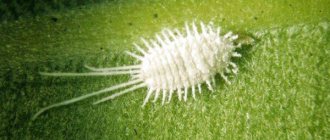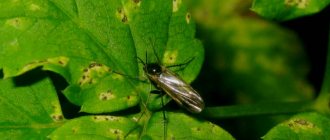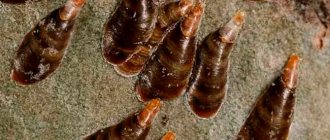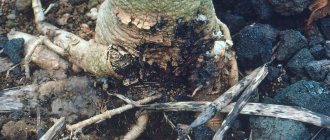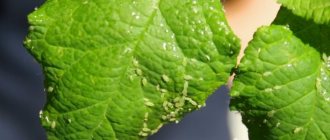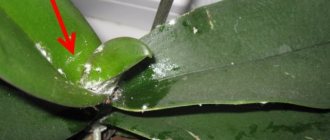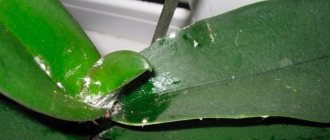Mealybug is an insect that is found on orchids; not everyone knows how to get rid of it. It is not difficult to recognize the pest. If you treat plants in a timely manner, you will be able to protect them from insects.
How to get rid of mealybugs on an orchid is of interest to many gardeners. The plant is exotic, the queen among indoor flowers. Despite the fact that flowers grow indoors, they cannot be completely protected from pests. To save plants, you can use traditional methods or chemicals.
Reasons for appearance on indoor flowers
For the most part, insect attacks on orchids occur in winter. This is due to metabolic disorders in plants due to lack of sunlight. In addition, there are several other causes of insect damage:
- incorrectly selected seasonal temperature regime;
- low indoor air humidity;
- excess nitrogen content in the substrate;
- untimely removal of dead leaves from the plant;
- non-compliance with the irrigation regime, which led to waterlogging;
- lack of water procedures.
Mealybugs can get indoors along with new plants or when purchasing soil.
As a rule, the likelihood of being affected by these pests is high in weakened specimens.
What causes mealybugs to appear on orchids?
There are more than a thousand species of this insect in nature. But often the citrus and bristly species settle on the orchid. Regardless of what type of pest has “occupied” the indoor orchid, there can be many reasons for its appearance.
The most common reasons for the appearance of mealybugs on orchids are:
- excess feeding,
- insufficient amount of light,
- temperature violation,
- low quality substrate
- frequent watering,
- watering with cold water.
Also, we must not forget about neighboring plants; if such pests were noticed on one orchid or another indoor plant, then the infected plant must be removed from the total mass of plants.
If this is not done, insects will be able to infect all other plants, since male mealybugs are able to fly from flower to flower.
Varieties and descriptions with photos
Of the numerous representatives of scale insects, several species cause particular concern to gardeners.
Citrus
Pseudococcus calceolariae. It is distinguished by a light crimson body covered with white wax, and the presence of 17 pairs of posterior wax filaments, the size of which is a third of the length of the entire body. Adult females reach up to 4.5 mm in length and 2.5 mm in width.
Bristly
Pseudococcus longispinus. It has a flat, elongated oval body with a gray-yellow or greenish tint, covered with white powdery wax. Forms a cotton wool-like mesh that shelters the larvae.
Seaside
Pseudococcus affinis is characterized by a light gray or pink oval body, 5 mm long and 3 mm wide, and well-developed legs. Males fly throughout the summer.
Grape
Pseudococcus citri - has an oval body 4 mm long and 3 mm wide, the shade of which varies from pink to greenish. Of the 18 pairs of wax filaments, increasing towards the posterior end of the body, the last one is the longest.
Description of the insect and the damage caused
Mealybug is an insect with an oval, waxy body up to 6 mm long, usually colored white, light beige or pinkish. People call these insects “hairy lice” or “felt lice.” The insect has transverse grooves on its back, and small bristles are located along the perimeter of the body. These insects, which are relatives of scale insects, inhabit not only plants, but also the substrate in pots.
Male scale insects are equipped with wings, but they do not have a mouthparts: adult individuals do not require food, since they die after mating. Females do not have wings, but they have a long proboscis with which they pierce the ground organs of the plant to suck out the juice. Before laying eggs, the female produces a cotton-like substance that covers plant leaves with a white coating. It is by this coating that the presence of scale insects is guessed.
In one season, scale insects produce 3-4 generations, and the light gray fluffy larvae also begin to suck the juice from the orchid.
Most often, scale insects hide in the depths of leaf axils and crawl into buds and flowers. As a result of their vital activity, the leaves become covered with a white marble pattern, the orchid flowers are deformed, the plant weakens and becomes easy prey for various infections, and the digestive enzymes of the pests slow down the metabolic processes in the plant. The sweetish secretion of scale insects, which is more often called honeydew, is a favorable environment for the sooty fungus, which covers the ground organs of the orchid with a black coating.
Signs of infection
The presence of a mealybug will be indicated by the following signs:
- the presence of a white coating on the leaf blades, buds and shoots, similar in appearance to powder;
- the appearance of shine and stickiness on the leaves due to the secretion of sweet nectar by the larvae - honey dew;
- deformation of flowers and buds (with prolonged parasitism);
- curling of young shoots;
- the formation of peculiar lumps on the plant, reminiscent of fluff or cotton wool.
An orchid affected by a mealybug is deprived of nutrients, which causes rapid depletion and death.
Sign of defeat
It is impossible to confuse a mealybug with another insect. The main sign of plant damage is the appearance of a white waxy coating. It looks like a piece of cotton wool.
In addition, sticky discharge appears on the leaves. The plates become stained. If you do not immediately take measures to destroy the pest, the plant will soon die.
How to get rid of it: pest control measures
If a mealybug is detected on an orchid, several actions must be taken immediately:
- Cut off and destroy flower stalks with buds.
- Remove pests from the affected parts of the plant using a toothpick or tweezers.
- Treat the leaf blades with a cotton pad soaked in alcohol or calendula tincture.
In some varieties, young scale insects prefer to settle under the young scales covering the pseudobulbs. In this case, the scales must be removed, and the pseudobulb must be treated with a sponge, which allows you to eliminate individuals that are not yet visible to the eye. If the leaves of the plant are affected, they are also removed.
Next, you need to process the flower.
How to identify a pest
Mealybugs are small insects measuring 3-6 mm. Their oval body is covered with a waxy coating. At the back there are plates of varying lengths. The color of insects is white or beige. There are small bristles along the body, and transverse grooves on the back. Pests are mobile at any age, they move around the plant, sink into the substrate, and spread to neighboring indoor flowers. Mealybugs belong to the superfamily Coccidae. They are close relatives of scale insects, another species of insect that parasitizes orchids.
Information. The common name for mealybugs is hairy lice.
In scale insects, sexual differences are clearly expressed. Males have wings but lack mouthparts. Adult males do not feed. After mating, they soon die. Wingless females live in large colonies. They have a long proboscis for piercing the plant and sucking out the juices. Before laying eggs, females create white, cotton-like pouches. On the leaves of plants they look like a coating, which is used to determine the presence of a mealybug on an orchid.
Fertile females produce 3-4 generations of insects per season. The larvae, emerging from the eggs, actively move throughout the plant. They look like light gray fluff. After choosing a convenient place, the larvae stick to the plant and feed on the sap. Soon they molt, and the older individual looks for a new place. Females can lay eggs in a secluded place near a flower, and the larvae find their way to the orchid.
The pest prefers to live and feed in the recesses of leaf axils. Adult females crawl into orchid buds and flowers. With severe damage, the flowers become deformed and a marbled color appears on the leaves. Mealybug weakens the plant, contributing to the appearance of secondary orchid diseases. In addition to sucking out nutritious juices, the pest leaves specific secretions that end up inside the leaves and flowers. The parasite's digestive enzymes slow down the metabolic processes of indoor plants.
Treatment with folk remedies
You can fight mealybugs not only with the help of chemicals, but also with folk remedies. Their use has the following advantages:
- availability;
- absence of aggressive components;
- environmental cleanliness.
However, this option is recommended only if the pest is timely detected and has not yet had time to reproduce.
The most common folk recipes:
- Soap solution. For this purpose, it is best to use green soap. To prepare, dissolve 15 g of soap in 1 liter of water, then treat the orchid at least 3 times with an interval of 7 days. Wash off the solution 24 hours after each use. You can enhance the effect of the working composition by adding 2 tbsp. l. vodka or 1 tbsp. l. alcohol
- Tinctures of medicinal herbs (horsetail, calendula). Pour boiling water (100 g/1 l) over the herb, let it steep, pour into a spray bottle and spray on the affected orchid.
- Composition of olive oil and water. Mix the components in a ratio of 2 tbsp. l. per 1 liter and treat the plant with it using a spray bottle. After approximately 2 hours, wash off the working composition.
- Garlic infusion. Crush 6 garlic cloves and pour boiling water over them. Leave for 4 hours, filter and apply to the affected parts of the plant using a soft cloth.
- Hot shower. The water temperature should be about 30 degrees. The pot with the flower is placed in the bathroom and the plant is poured out of the shower for 15 minutes. After which it is necessary to remove all moisture from the axils of the orchid using a paper napkin.
LiveInternetLiveInternet
Quote from VezunchikI
Read in full In your quotation book or community!
How to get rid of mealybugs on an orchid? Adviсe.
If you suddenly find white flakes on your indoor plants that resemble lumps of cotton wool, this means that they have been attacked by a mealybug .
Mealybugs, or often called hairy lice, are sucking insects that are clearly visible to the naked eye. Scale insects get their name because of their white, waxy secretions that resemble clumps of cotton wool. Mealybugs (Pseudococcidae) are a close relative of scale insects and pseudoscale insects.
The insects that are located directly on the flower and cause the most damage are the females. They practically do not move, strengthening in one place and forming a white coating around themselves, similar to cotton wool. It is this plaque that is the most noticeable signal that there is a harmful insect on your orchid. Having seen the plaque, you can also notice the insects that are located under it, which are the scale insects themselves, which you need to get rid of as soon as possible, since they can cause many diseases of the phalaenopsis orchid.
The action of mealybugs has a truly profound detrimental effect on the plant, since they suck out the juices from the orchids, at the same time injecting toxic substances into the flower, which makes the orchids weak, their growth slows down, the leaves fall off and turn yellow. The first symptoms you will probably notice will be sticky droplets all over the surface of the leaves. During the same period, a white coating may form, which we have already mentioned, and which is even easier to notice. If the damage to a flower is prolonged and severe, this can often cause deformation of flowers and buds, as well as marbled leaves with the appearance of yellow or red spots.
The main reason for the occurrence of these insects on orchids is suboptimal living conditions. This means that these pests almost never appear on healthy plants that are immune to them. In most cases, they affect plants that are already weakened, whose metabolism has been disrupted for one reason or another. Often this can be due to nitrogen oversaturation, which can also be detrimental to the health of the orchid. You need to be especially careful in winter, since it is the most dangerous from the point of view of complicating the creation of the necessary climate for the orchid, with the presence of proper lighting, fertilizer, temperature, moisture, and the like.
In addition, the scale insects leave behind a sweet sticky secretion, honeydew, on which black mold, similar to soot, or sooty fungus quickly settles.
To get rid of mealybugs , wipe the plant with a solution of alcohol, beer or soapy water. If there are few insects, you can collect them manually, but you will still have to process the plant. If there are a lot of scale insects , use an anti-scale insecticide based on imidacloprid, which does not contain paraffin, which is poorly tolerated by indoor plants. If the store does not have such a product, then you can use fitoverm, actellik, phosphamide, metaphos, actara, mospilan. In addition to spraying with the same solution, spill the soil in the pot. Such treatments will have to be repeated after a week, possibly more than once.
The plant on which the mealybug is found must be isolated and quarantined for two weeks. Unless the insects no longer appear, only then can the plant be returned to its place in the collection.
To protect yourself and others from the harmful effects of the poison, as well as to enhance the effect on pests, place the treated plant along with the pot in a large plastic bag. Spray the entire plant, not just the affected leaves. Then tie the bag for 2 hours.
If there were a lot of scale insects, then at the same time (the next day) you need to treat the plant against sooty fungus with a solution of copper sulfate and soap, Bordeaux mixture.
Carefully inspect all indoor plants to see if there are any scale insects on neighboring plants. In order to prevent the presence of scale insects, it is recommended to spray indoor plants with phytoverm. This drug is not considered toxic to humans.
To prevent mealybugs, regularly inspect the inside surfaces of houseplant leaves, especially if the leaves are dense, smooth, and tough. Do not over-moisten the soil or create cold drafts.
https://floweryvale.ru/houseplants/how-to-get-rid-of-mealybugs.html
Mealybug: control measures
How to deal with mealybugs? Check the soil and stems of new flowers you bring into the house; if you find any pests, crush them and wash them with a rag. A touch of alcohol will kill the insect. Soap and oil sprays kill the pest. Treatment with pesticides will give a very quick but short-term effect. Severely affected plants should be discarded. Only systemic poisons can help fight mealybugs.
Fighting this pest is a rather complex process. Mealybugs do not tolerate heat and humidity well. Feeding with nitrogen fertilizers leads to rapid reproduction of the pest. Ants are also carriers of mealybug larvae, so they should be carefully destroyed. First of all, the plant must be rinsed well with warm water and laundry soap. Next, spray it weekly with a solution of tobacco, green soap (15 g/l), garlic infusion, and alcohol solution (add 20 g of liquid soap and 20 ml of alcohol to 1 liter of water). When watering with insecticides, the mealybug remedy is absorbed by the plant and the insects are poisoned.
How to get rid of mealybugs if the plant is severely affected by the pest?
In this case, the indoor plant must be washed with soapy water and sprayed with Aktara, Fozalon, and Intavir. If there is a problem with re-treatment, it is necessary to change the drug. If the roots are damaged, they are washed with insecticide, the soil is changed, and the pot is thoroughly treated.
When your favorite plant is suddenly overcome by a mealybug, treatment can also be carried out using folk remedies. These include horsetail tincture, olive oil solution and garlic tincture. These folk remedies need to be sprayed on the diseased plant 3-4 times a week.
Houseplant lovers should learn how to deal with mealybugs. The most effective way to control mealybugs is the chemical Pyrethrum. The drug is absorbed by the plant and, getting into its juice, poisons the pest. An excellent remedy for mealybugs are systemic poisons such as Actelik.
Source: https://womanadvice.ru/muchnistyy-chervec#ixzz3cBNMCL7e
So, to summarize:
What can you do to ensure that you no longer recognize what a mealybug is?
- Firstly, you need to inspect all the plants that you bring home and place together with existing flowers, because this is one of the most common types of this insect getting into your flower collection. Thus, we advise you to carefully examine all the flowers that you already have, and especially those that you have recently purchased.
REGULAR CONTROL is the best prevention. The sooner you recognize an insect, the greater your chances of quickly getting rid of it. Particular attention should be paid to flowers, peduncles, young leaves and new shoots, since they contain the largest amount of amino acids that attract mealybugs.
- In order to protect your plants from any harmful influence, they should be subject to regular inspection, which will help you prevent the appearance of “unexpected guests”.
- Preparations based on NEEM TREE OIL (Schädlingsfrei Neem) have proven themselves very well as a preventive remedy. They can do an excellent job even with a small lesion, however, a large population is too tough for this drug.
Rules for how to properly deal with mealybugs:
- Isolate it from all other plants, protecting them from the possibility of infection;
- Mechanical cleaning - removing flowers, buds, cleaning infected leaves with a cotton swab, removing insects from the entire surface of the flower;
- Removing severely affected leaves;
- Thoroughly clean the trunk and other parts of the orchid from insects;
- Moving the plant to an environment with higher temperatures and higher humidity, since such conditions negatively affect mealybugs;
- Carefully inspect and clean all objects around the environment where the flower was located, since insects may also be on external objects
- Alternatively, you can treat the plant with medications or folk remedies that help in the fight against this type of insect.
- Adults of almost all mealybug species die at temperatures of + 35 °C and above. Some species are faster, others are slower, so an essential assistant in preventing the occurrence of the pest is watering orchids using a “hot” shower at a water temperature of 40 to 52 ° C
From our own experience, we can recommend the use of the following chemicals for treating plants for the final and reliable destruction of mealybugs: Dimethoat, Parathion, Malathion, Diazinon
In order to ensure complete destruction of pests, these medications will have to be used 3-4 times with an interval of 10-14 days.
There is a lot more about WAYS TO FIGHT mealybugs - https://www.orchidee.ws/schadlinge/wolllaeuse/wolllaeuse.htm
Orchids - daughters of joy
There are many fabulous legends about orchids. Here's another one of them.
Once upon a time, gods lived on earth. Among them was the beautiful Orchid, the daughter of the god of honesty and the goddess of joy. Most of all in life she loved light, she never noticed a shadow, did not see the rough and ugly, the dark and monotonous.
But the gods looked at the orchid differently. Some of them condemned her, considered her too young and narrow-minded. This perception of the young goddess led to a quarrel between the gods. One part of them believed that the parents did not raise the orchid correctly, that the girl could not develop fully in a family oversaturated with joy. The gods demanded that there be some indifference in education. These gods adhered to the patriarchal principles of life; they believed that only knowledge of the whole is good.
These gods, conservative gods, accused the orchid of ignorance, lack of wisdom and incorrect perception of reality. And in the land of the gods it was impossible to exist without enough wisdom. Therefore, there was a threat to Orchid’s life.
But another part of the gods protected and justified the girl. They explained the Orchid's vision as a phenomenon of progress, promising a more spacious future. They perceived Orchid as a more exalted entity. The liberal gods saw the young beauty as a tool that could be used to destroy the narrow-mindedness and a kind of ignorance that had penetrated the world of the gods.
At this time, the god Archie fell in love with Orchid. The peculiarity of these feelings was that he had never seen her, only heard about her mysterious vision of the world, about her kind soul. He patronized all types of arts. But Archie could not teach people art without recognizing shadows and lines, and Orchid saw only her own inner world. There were no shadows, light without darkness, and lines without color. Because of his love for Orchid, God began to lose his skill, but he could not do anything - he loved her too much.
And the gods forbade meetings between lovers. The orchid was isolated from society; no one was allowed to meet with it. Then Archie kidnapped her. This act was unforgivable in the divine world. Archie was banished to the forests. And the Orchid, having learned about the expulsion of her beloved, plunged into eternal sleep and turned into a forest flower. Thus the lovers were reunited.
https://orhidey.com/articles/orxidei-docheri-radosti.html#sthash.mLNnXTdJ.dpuf
How to get rid of orchid pests (advice from forums, choose) :
- For 1 l. Dilute 1 teaspoon of fairy and 2 tablespoons of vodka with hot water, cool and spray the entire orchid with this.
- Dilute 20 g of liquid soap (I used FAIRY) in 1 liter of hot water, cool and add 20 ml of alcohol (vodka) to the solution. First, remove the reptiles with a toothpick dipped in alcohol, and then spray and wipe the plant. Repeat after 3-4 days.
By the way, it also helps against scale insects!
- Spray a large plastic bag with dichlorvos and place the orchid there (this is how we ensure that we do not directly spray parts of the plant with a toxic substance, but at the same time the smell kills the pest). Tie the bag for a couple of hours. (They say it works!)
- Treat the plant with green soap (according to the instructions).
- Take 2 insecticides with different active substances. For example, Aktara and Konfidor. We dilute as per the instructions and spray + water, leave in the bathroom for half an hour, after 4-5 days - another drug. Within a week the worm was gone and is still there to this day.
- Here is another recipe for dealing with scale insects:
Sequential treatment with Commander (1 sachet per 5 l) - spray and spill the soil, then Aktara (5 g per 5 l) and again after 7 days.
- I poured pure medical alcohol directly into the sinuses and into the outlet (don’t overdo it!). Bugs don’t like alcohol. Deadly.
- The mechanical method of dealing with scale insects is very painstaking and thankless.
work. In addition, methyl alcohol is poison for them, and ethyl alcohol is of no use to them.
If you manage to select these bastards, wash them, and fill them with alcohol, then it means there were few of them,
and they did not have time to reproduce. And if they appear at intervals of 10-20-30 and
more than days and there are many of them, you need to fight only with chemistry. I used a systemic contact-intestinal insecticide based on imidacloprid - Confidor maxi. Double treatment saved my blooms. The consumption rate of the drug is 2 ml per 10 liters of water, i.e. only 0.2 ml per 1 liter. This is not the amount of chemicals that can affect a person. By the way, decay products during the combustion of household gas are formed in much larger quantities and are no less harmful.
Plants need to be watered 2 times every 10 days and mealybugs. I haven’t seen them for over a year now and I’m no longer nervous about them.
- Use a cotton swab heavily moistened with alcohol to remove this muck wherever you see it. Then dilute alcohol 50X50 with warm, boiled water, spray the rastushka, and soak the roots in Confidor (dilute a sachet per liter), and after 10 days soak in Aktar. Nothing will appear!
- Just “salt” the substrate with Aktara on top and that’s it. Reliable, fast and does not require reprocessing. When watered, it gradually dissolves and enters the plant. (I sprinkle it by eye. Depends on the pot... well, maybe even less on the tip of a teaspoon.)
( https://orchclub.com.ua/viewtopic.php?f=50&t=501 )
I wish no one to get SICK!!!!!!!!!!
Chemicals: how to treat?
Modern manufacturers present a variety of chemical preparations that can effectively eliminate pests on indoor plants. The advantages of using them are as follows:
- the ability to quickly penetrate orchid juice, making it poisonous;
- creation of reliable protection for a relatively long period;
- the ability to eliminate parasites in hard-to-reach places.
Disadvantages of chemicals:
- high toxicity to people and pets;
- causing addiction of some drugs in mealybugs.
The most popular chemicals among gardeners include:
Aktellik
Created on the basis of pirimiphosmethyl. Getting into the body of scale insects with plant juice, it has a detrimental effect on them.
Due to high toxicity, it is not suitable for preventive treatments.
Fitoverm
Insectoacaricide of biological origin. Due to the lack of toxicity, it is ideal for treating indoor plants. Has a contact-intestinal spectrum of action.
Aktara
Made from thiamethoxam. Penetrating inside the leaf plates, it infects pests during feeding. Characterized by high power of action. Involves processing up to 4 times with an interval of 10 days.
Calypso
Created on the basis of thiacloprid. Blocks the transmission of nerve impulses of parasites, which causes their death. It is considered an intestinal and contact insecticide.
Treatment with the drug is carried out up to 2 times with an interval of 40 days.
Bankol
A drug based on bensultap. Kills pests through direct contact or feeding. Not recommended for use during flowering.
Mospiplan
Contains acetamiprid and is not addictive to parasites. It has a contact-intestinal effect and provides protection for 3 weeks.
What do mealybugs look like?
Mealybugs, or, as they are popularly called, hairy lice , are sucking insects that are clearly visible to the naked eye. They got their name from the white cotton wool-like waxy secretions. Larvae and adult females suck young shoots, leaves, and buds. They greatly retard plant growth. The common citrus mealybug also attacks the root system.
Insects are very mobile and move well at almost any age, covered with a white powdery waxy coating, often with waxy plates along the edge. Dimensions 3-6 (0.5-12) mm, depending on the type.
Sexual dimorphism is pronounced (when individuals of the same species have two forms that differ in physiological characteristics). Males have wings (usually the first pair), normally developed limbs, and an abdomen with two tail filaments. There is no mouthparts (males do not feed as adults).
In a number of species, legs are reduced or absent. The oral apparatus is sucking. Most insects lay eggs; in some species, females are viviparous. The eggs are laid in a white cotton wool-like facial sac. Fertility is very high; many forms give 2, sometimes up to 4 generations per year.
Larvae of the 1st instar (vagrants) actively move along the food plant and can be carried by the wind. Having attached themselves to the plant, the larvae lose mobility; After molting, the larvae of the next instar again look for places to feed. Adult females of some species can actively crawl along the food plant. Before oviposition, many forms leave the feeding area and go into shelter.
There are over 1,600 species of scale insects in the world fauna; they are distributed everywhere, but mainly in the tropics. Among the scale insects there are many pests of fruit, industrial, ornamental crops and greenhouse plants. The most famous are the greenhouse lamellar bug, the Australian grooved bug (a pest of citrus fruits, a quarantine object), the bamboo bug, the citrus bug, the seaside bug, the grape bug, the Comstock bug (a mulberry pest), and the olive pollinia.
Some species of scale insects secrete useful substances used in the paint and varnish industry (varnish scale bug and cochineal, which produces red paint - carmine).
Mealybug. © Edson Momm
Mealybugs are easily recognized by their white cotton wool-like waxy coating; as a rule, they are clearly visible to the naked eye. Sugary discharge (honeydew) and a sooty fungus settling on it are the following symptoms of damage.
What to do for prevention?
Compliance with preventive measures allows gardeners to significantly reduce the risk of orchids being damaged by mealybugs. To do this, the following is recommended:
- Carefully inspect the plant when purchasing.
- Maintain the necessary air humidity and lighting in the room.
- Follow the watering and fertilizing regime.
- Trim dried fragments in a timely manner.
- Periodically inspect plants for lesions.
What to do for prevention?
An orchid can be considered completely healthy only if not a single white mealybug cocoon appears on the plant within 1 month.
To prevent this indoor plant from having such a problem, it is necessary to organize a warm shower once a month.
To do this, you need to remove the orchid from the pot and wash the roots, center of growth, leaves, peduncles and flowers under a moderate stream of shower with warm water.
When the water has drained well, the center of the orchid's growth should be wiped dry with a dry paper napkin. No moisture should remain in this area, as this can lead to rotting of the plant.
Experienced flower growers recommend organizing a month of quarantine for each new orchid. Of course, you want to immediately place the new plant among the others, but you don’t need to do this right away. A new flower from the store may be infected. The purchased orchid needs to be placed in a separate bright place for 1-1.5 months. During this time, the owner must make sure what condition his new orchid is in. If the plant does not weaken and continues to grow and flower, then it can be safely rearranged with other indoor plants.
You also need to be careful about mineral fertilizers. An orchid should be fed exclusively during the period of growth and flowering. Do not overdo it with the amount and concentration of fertilizer. The feeding process should be carried out no more than once every 2 weeks.
It should be remembered that there are special fertilizers for orchids. To prevent the plant from getting sick and actively forming buds in winter, it is necessary to pay attention to the temperature of the air and water for irrigation. The water temperature should not be lower than +35+36°С, while the air temperature in the room should not fall below +20…+22°С.
